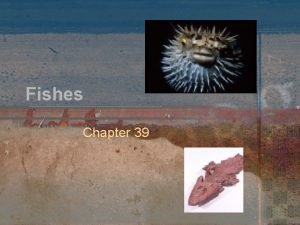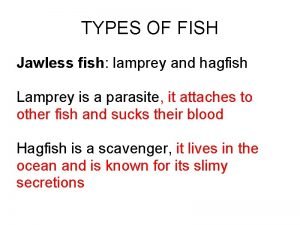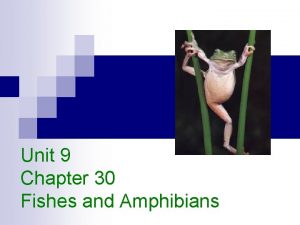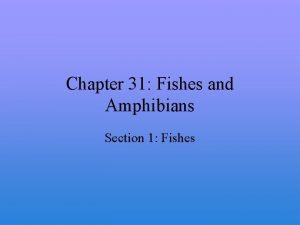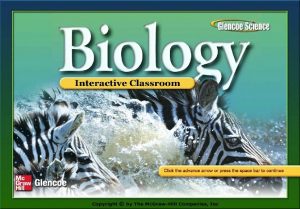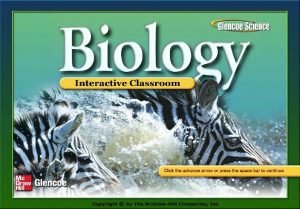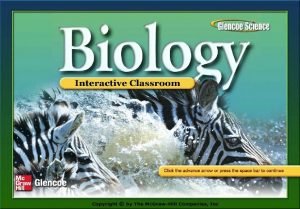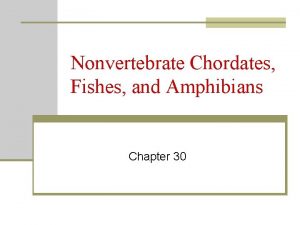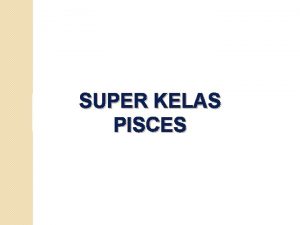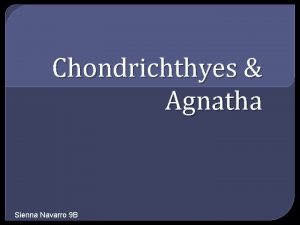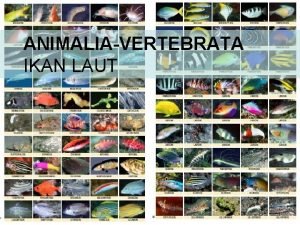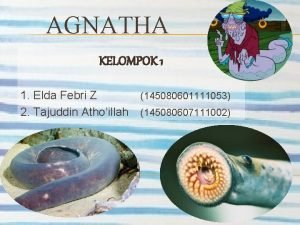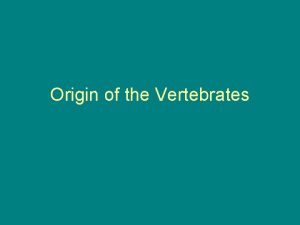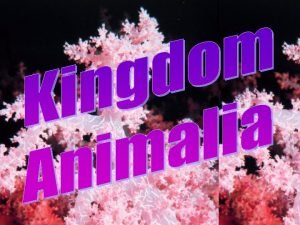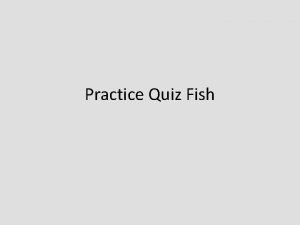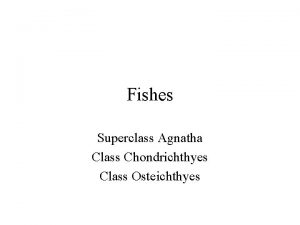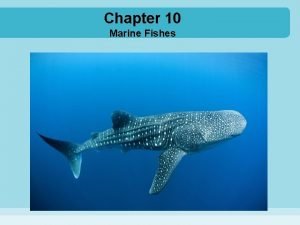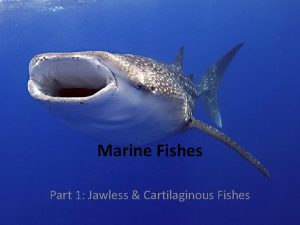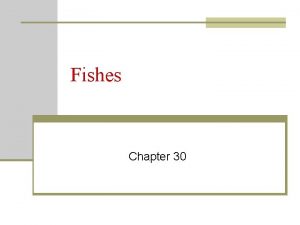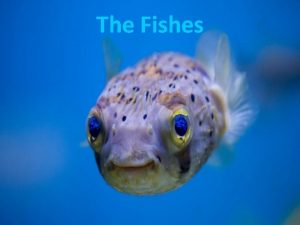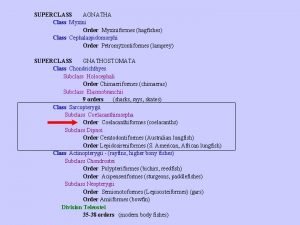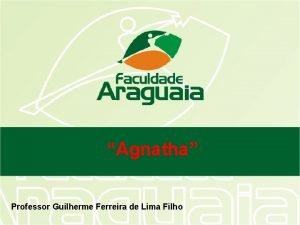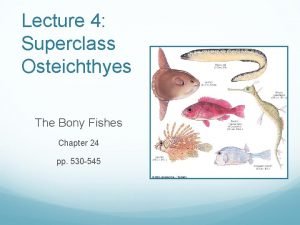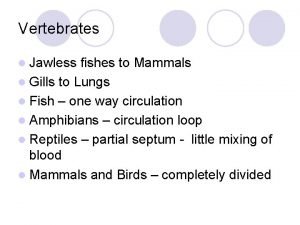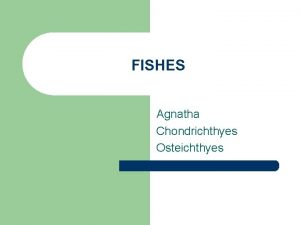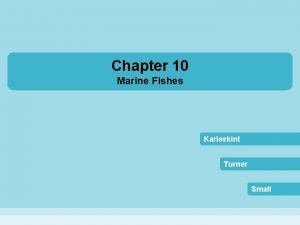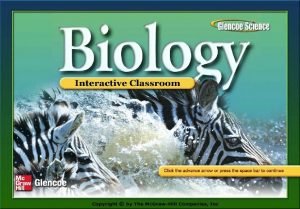Lecture 2 Superclass Agnatha The Jawless Fishes Chapter


















- Slides: 18

Lecture 2: Superclass Agnatha The Jawless Fishes Chapter 24 pp. 520 -525

I. Classification A. Living Classes 1. Myxini (Hagfish) ~70 species 2. Petromyzontida (Lamprey) ~30 species

B. General Characteristics Body structure Rounded, eel like body Pore-like gill openings No paired fins No jaws No scales No internal ossification (bones)

C. Class Characteristics 1. Class Myxini (Hagfish) Gr. myxa=slime -Marine -Blind, but keen sense of smell/touch -Scavengers/predators on annelids, mollusks, crustaceans, & dead or dying fish -Secrete milky slime when threatened -Reproductive biology still a mystery

2. Class Petromyzontida (Lamprey) Gr. petros, stone + myzon, sucking -Marine & freshwater -Sucker-like oral disc/tongue with keratinized teeth -Use mouth to grasp stone to hold position in current -Can be up to 1 meter long -Non-parasitic forms: do not eat after emerging as adults -Parasitic forms: attach to prey and suck out fluids

II. Body Systems A. Skeletal/Muscular 1. Fibro-gelatinous notochord -exists throughout lifecycle -provides attachment for “W” shaped, serially arranged muscles (myotomes) -muscles contract to produce S-shaped eel-like movements 2. Incomplete cartilaginous skeleton -in head, around gills & notochord

II. Body Systems B. Respiratory/Circulatory 1. Gills -5 -16 pairs, variable number of openings (hagfish) -7 pairs, each with external opening (lamprey)

II. Body Systems B. Respiratory/Circulatory 2. Heart -1 heart with atrium (blood holder) and ventricle (blood pumper) -aortic arches around gills -accessory hearts in caudal end (hagfish) -cold-blooded (ecto-thermic)

II. Body Systems C. Nervous 1. Dorsal nerve cord 2. Differentiated brain – cerebellum present in lamprey; not in hagfish 3. Pineal gland (on brain) -senses light 4. Other sense organs for taste, smell, and hearing 5. Eyes well developed in adults

II. Body Systems D. Digestive 1. System -Mouth, pharynx, esophagus, intestine (liver), rectum, anus -No stomach

II. Body Systems D. Digestive 2. Feeding -described above in slides 4 &5 -Major pests in the great lakes in 1950’s & 1960’s -Lampreys parasites of commercial fish -Hagfish predators of fish in nets -Various monitoring efforts in place

II. Body Systems D. Digestive 3. Specialization -Mouth Parts Rasping tongue to grind off pieces of flesh Sucker-like mouths for easy attachment -Flexibility Knot tying to create more pressure against prey

II. Body Systems E. Excretory/Water Balance -primitive opisthonephridic kidneys run length of body for regulating water balance -pump in and out water (osmosis) and ions to regulate water balance

II. Body Systems F. Reproduction Basics 1. Hagfish -separate sexes (dioecious) -both ovaries/testes; one non-functional) -external fertilization -large yolky egg -no larval stage

II. Body Systems F. Reproduction Basics 2. Lamprey a. Facts -separate sexes (dioecious) -single gonad without duct -external fertilization -long larval stage: ammocoete

II. Body Systems F. Reproduction Basics b. Lamprey Life Cycle Ø Ø Ø Ø Spawn in fresh water streams Eggs fertilized externally Eggs hatch in 2 weeks Larvae drift down stream and bury in fine sand Larvae filter food out of the water for 3 – 7 more years Rapid metamorphosis to adult Adults only live ~ 1 year

III. Fun Facts Hagfish in store market & later stir-fry (Korea) Lamprey Pie (London) & Salad (China)

IV. Alien Invaders Video http: //www. youtube. com/w atch? v=Eqsko. RWMXb. A - Note taking & Summary: Write down 5 fact-filled sentences during video 1. ________________________ __ 2. ________________________ _ 3. ________________________ _ 4. ________________________ _ 5. _________________________ Summarize the issue and your reaction to it on right
 Section 39-3 review bony fishes
Section 39-3 review bony fishes Characteristics of jawless fish
Characteristics of jawless fish Class of jawless fish
Class of jawless fish Types of jawless fish
Types of jawless fish 01:640:244 lecture notes - lecture 15: plat, idah, farad
01:640:244 lecture notes - lecture 15: plat, idah, farad Chapter 30 fishes and amphibians
Chapter 30 fishes and amphibians Chapter 31 fishes and amphibians answer key
Chapter 31 fishes and amphibians answer key Chapter 28 section 1 fishes study guide answer key
Chapter 28 section 1 fishes study guide answer key Chapter 30 fishes and amphibians worksheet answers
Chapter 30 fishes and amphibians worksheet answers Concept mapping chapter 28 fishes and amphibians
Concept mapping chapter 28 fishes and amphibians Non vertebrate chordates
Non vertebrate chordates Agnatha chondrichthyes osteichthyes
Agnatha chondrichthyes osteichthyes Ichthyes meaning
Ichthyes meaning Klasifikasi osteichthyes
Klasifikasi osteichthyes Cara reproduksi agnatha
Cara reproduksi agnatha Agnatha
Agnatha Agnatha
Agnatha Are agnatha endothermic or ectothermic
Are agnatha endothermic or ectothermic How do hagfish feed
How do hagfish feed
